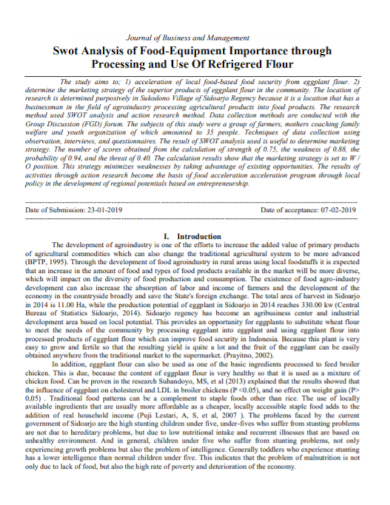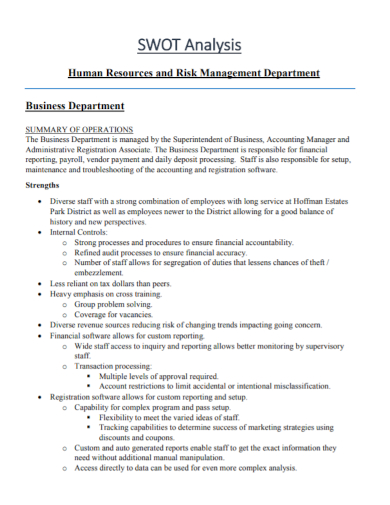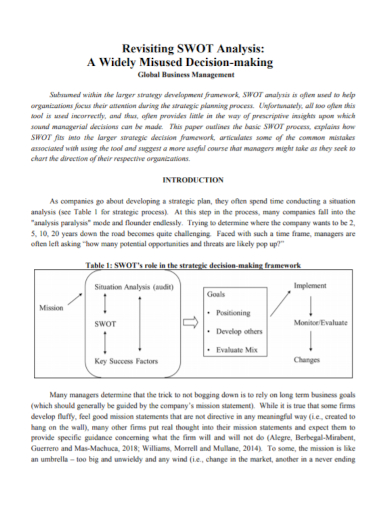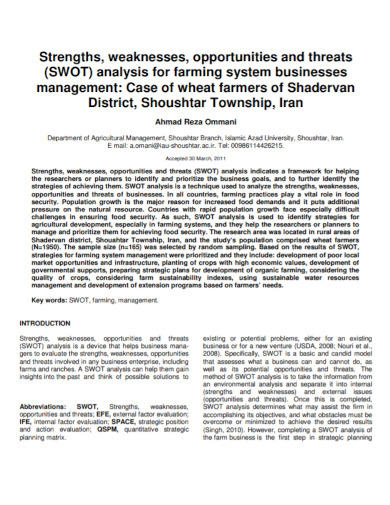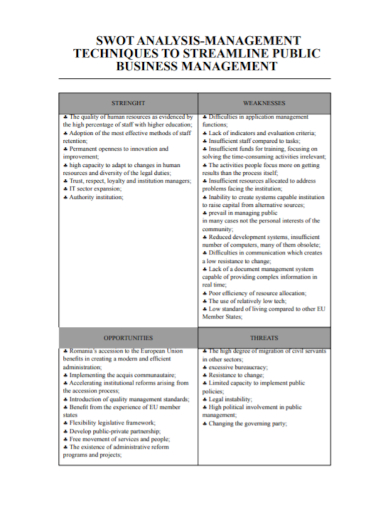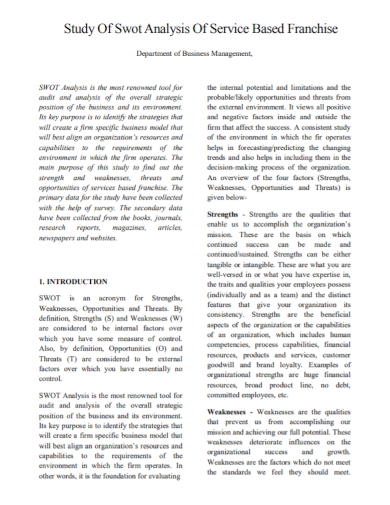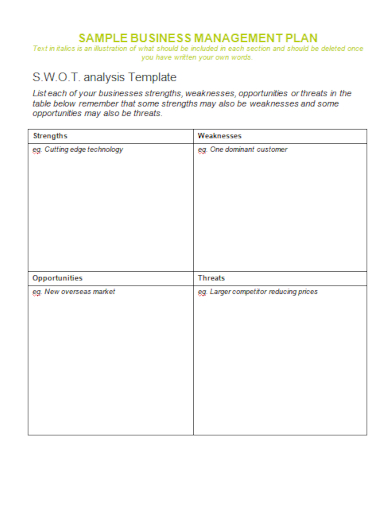7+ Business Management SWOT Analysis Samples
One can view an organization’s business as their life; and one of the many things that is needed in life is a plan. As it serves as a basis for an establishment or a business’s guide as they enact their agenda. Plans ensure that a certain framework encompasses all the actions they make take. Allowing the company to be cohesive and efficient in all the business-related activity they may undertake. In this article, we provide you with free and ready-to-use samples of Business Management SWOT Analysis to help you start assessing your business’ strengths, weaknesses, opportunities, and threats. Keep on reading to find out more!
1. Business Management SWOT Analysis
2. Journal Business Management SWOT Analysis
3. Business Risk Management SWOT Analysis
4. Global Business Management SWOT Analysis
5. Business Management System SWOT Analysis
6. Business Management Technique SWOT Analysis
7. Business Management Study SWOT Analysis
8. Business Management Plan SWOT Analysis
What Is a Business Management SWOT Analysis?
SWOT analysis is an acronym that stands for Strengths, Weaknesses, Opportunities and Threats. It is a type of study that seeks to identify the internal and external factors that may potentially affect your business. The strengths and weakness are derived by assessing the data found internally- these are usually things that are tangible or are within the bounds of one’s control: things like your employees, your products, the location your company is in. Meanwhile, opportunities and threats are usually external and are out of your control- a prime example is the market trends and the buying power of your potential consumer.
How to Make a Business Management SWOT Analysis
While making a SWOT Analysis for your business’ management definitely cannot be done by one person alone, it shouldn’t take you days to create one. Aside from the variety of free Business Management SWOT Analysis templates provided above, you and your team can also try making one of your own. If you’re interested in making an in-depth SWOT Analysis personalized for your business, here are the following general information you could use to do it the right way:
1. Gather the right people to do it.
The founders and leaders of the company must be deeply involved in a SWOT analysis for it to be effective. To get the best results, bring together a group of people with a variety of perspectives on the company. The idea is to have a variety of viewpoints to create an objective and in-depth SWOT analysis.
2. Brainstorm freely of your different ideas.
There are good and bad ways to do a SWOT analysis, just as there are right and wrong ways to conduct brainstorming meetings. To begin, everyone should jot down their thoughts on a piece of paper. This avoids groupthink and guarantees that everyone’s voice is heard.
3. Answer the S.W.O.T questions.
These questions can aid in the explanation of each part as well as stimulate creative thinking. Here are some questions of each category:
- Strength
- What are the strengths of your teams?
- What tangible assets, such as clients, equipment, technology, cash, and patents, do you have?
- What are your competitive advantages over your competitors?
- Weaknesses
- Is there anything your company needs to be competitive?
- What business procedures do you think should be improved?
- Do you require any actual assets, such as money or equipment, for your business?
- Opportunities
- Is your market expanding, and are there any trends that suggest consumers may want to buy more of what you’re selling?
- Are there any upcoming events that your firm may take advantage of to help it grow?
- Threats
- Will your suppliers always be able to provide you with the raw materials you require at the pricing you want?
- Is it possible that technological advancements in the future will alter the way you do business?
4. Sort your ideas into categories.
After you’ve sorted all of your ideas, it’s time to rank them. You and your colleagues can vote on which ideas are superior and which should be abandoned. As a result, the list is now open to debate and discussion, and someone in the room should be able to make the final decision on priority.
FAQ
What is the purpose of a SWOT analysis for a manager?
A SWOT analysis is used in business management to examine a company’s strengths and weaknesses in comparison to its competitors. In addition, before finishing a SWOT analysis, firm executives must examine a number of other issues, such as government regulations.
What is the significance of the SWOT analysis in business?
SWOT analysis is an important tool for evaluating a company’s internal and external environment by identifying strengths, weaknesses, opportunities, and threats. SWOT analysis is a great way to put your ideas to the test.
What are the two most important features of a SWOT analysis?
Drawing conclusions about the company’s overall position from the four SWOT lists and converting these conclusions into strategic actions to better fit the company’s strategy to its resource strengths and market possibilities are the two most significant components of SWOT analysis.
A SWOT Analysis can help you build on your strengths, solve your weaknesses, reduce risks, and maximize your chances of success. Download our easily customizable and printable samples of Business Management SWOT Analysis today!
Related Posts
FREE 10+ Analysis of Alternatives Samples in PDF
FREE 10+ Failure Mode and Effects Analysis Samples in PDF
FREE 10+ Make or Buy Analysis Samples in PDF
FREE 10+ Fishbone Root Cause Analysis Samples in PDF
FREE 11+ Cost Volume Profit Analysis Samples & Templates in PDF | MS Word
FREE 6+ Corporate Portfolio Analysis Samples in PDF
FREE 10+ Fault Tree Analysis Samples in PDF
FREE 10+ Comp Analysis Samples in PDF
FREE 10+ Fishbone Analysis Samples in PDF
FREE 10+ Individual Swot Analysis Samples in PDF
FREE 10+ 5 Year Analysis Samples in PDF
FREE 10+ Benefit Costs Analysis Samples in PDF
FREE 10+ Job Hazard Analysis Samples in PDF
FREE 10+ Primary Source Analysis Samples in PDF
FREE 10+ Critical Path Analysis Samples in PDF


